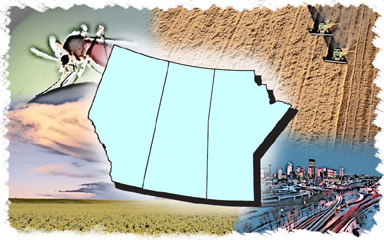Proactive disclosure
Print version   |  | 
Natural Resources Canada > Earth Sciences Sector > Priorities > Climate Change Impacts and Adaptation > Teacher's Guide
Climate Change in Canada Regional Aspects of Climate Change - The Prairie Provinces (Alberta, Saskatchewan, Manitoba)
According to Environment Canada, the yearly average temperature in the Prairie Provinces has warmed about 1.2°C over about the last 50 years - but winter temperatures have warmed about 3.0°C, and summer temperatures have only increased about 0.2°C. Since 1948, seven of the ten warmest years in the Prairies have occurred after 1981.
Most of the climate change scenarios that have been projected for the Prairie Provinces suggest that the southern Prairies can expect an increase in the frequency and length of droughts. This region could experience deficiencies in soil moisture by the end of the century. However, not all parts of the Prairie Provinces will experience the same effects. Some scientists suggest that, despite the increased frequency of droughts anticipated for most of the southern Prairies, this may not occur in southern Alberta.
Potential regional impacts
 
- Extreme events such as severe thunderstorms, tornadoes, hailstorms, and heat waves may become more prevalent in the Prairies.
- The average potential crop yields could fall by 10% to 30% by the end of this century, due to higher temperatures and lower soil moisture.
- Higher temperatures could lengthen the growing season in some places, and may increase crop production (and the production of more valuable crops) in northern regions where suitable soils exist.
- Increased demand for water pumping and summer cooling because of drought, and decreased winter demand for heating due to higher temperatures, could push electrical utilities into a summer peak-load position. At the same time, hydropower production will be reduced by decreased water flow. This could result in increased thermal power production with an increase in fossil fuel consumption and greenhouse gas emissions. Expect changes in your fuel bill.
- Semi-permanent and seasonal wetlands could dry up, leading to reduced numbers of waterfowl and other wildlife species that are dependent on wetland environments.
- A reduction in glacier-derived mountain streamflow could already be having an impact on native bull trout populations.
- A decrease in growth rate and timber production in southern forests is expected along with an expansion of grassland.
- Climate change may bring on more variation in the size of extreme flows in prairie rivers, leading to higher peak flows and lower low flows.
Curriculum linkages
Alberta

Science
UNIT D: Energy flow in global systems
(STSE and Knowledge outcomes)
- Explain how climate profoundly affects the lives of people and other species
in many ways, and explain the societal need to investigate climatic change.
- Describe, in general terms, the responses of human and other species to extreme climatic conditions.
- Describe the role of science in furthering the understanding of climate and climate change through international programs.
- Describe the role of technology in furthering the understanding of climate and climate change.
- Describe how rapid climatic change will result in population shifts and economic turmoil.
- Analyze the impact of change in global energy transfer systems on humans and the biosphere.
- Analyze the impact of human actions on energy transfer in biomes and their potential impact on climate.
- Describe and analyze the evidence for and against rapid climatic change brought on by human activity.
- Assess, from a variety of perspectives, the risks and benefits of human activity and its impact on the biosphere and climate.
Social studies
Interdependence in the global environment
Theme III: Quality of life c) Quality of life is increasingly affected by environmental issues of global concern.
Theme IV: Alternative futures: possibilities for change c) There are potential solutions to global concerns.
Manitoba

Science
Sustainable ecosystems, Weather dynamics
Sustainable development, II
(The new science curriculum courses that are not yet implemented will link directly with the Pan Canadian general and specific learning outcomes.)
Saskatchewan

Science
Core unit A: Earth/Environmental
| A1 Water quality: |
The role of humans in the biosphere - Chapter 3
- Pollution and environmental stress, p. 76
Chemistry in industry - Chapter 15
- Acid rain and our environment, p. 458
|
| A2 The greenhouse effect |
Health science connections
- 6.2 Altering the environment, p.170
|
|






